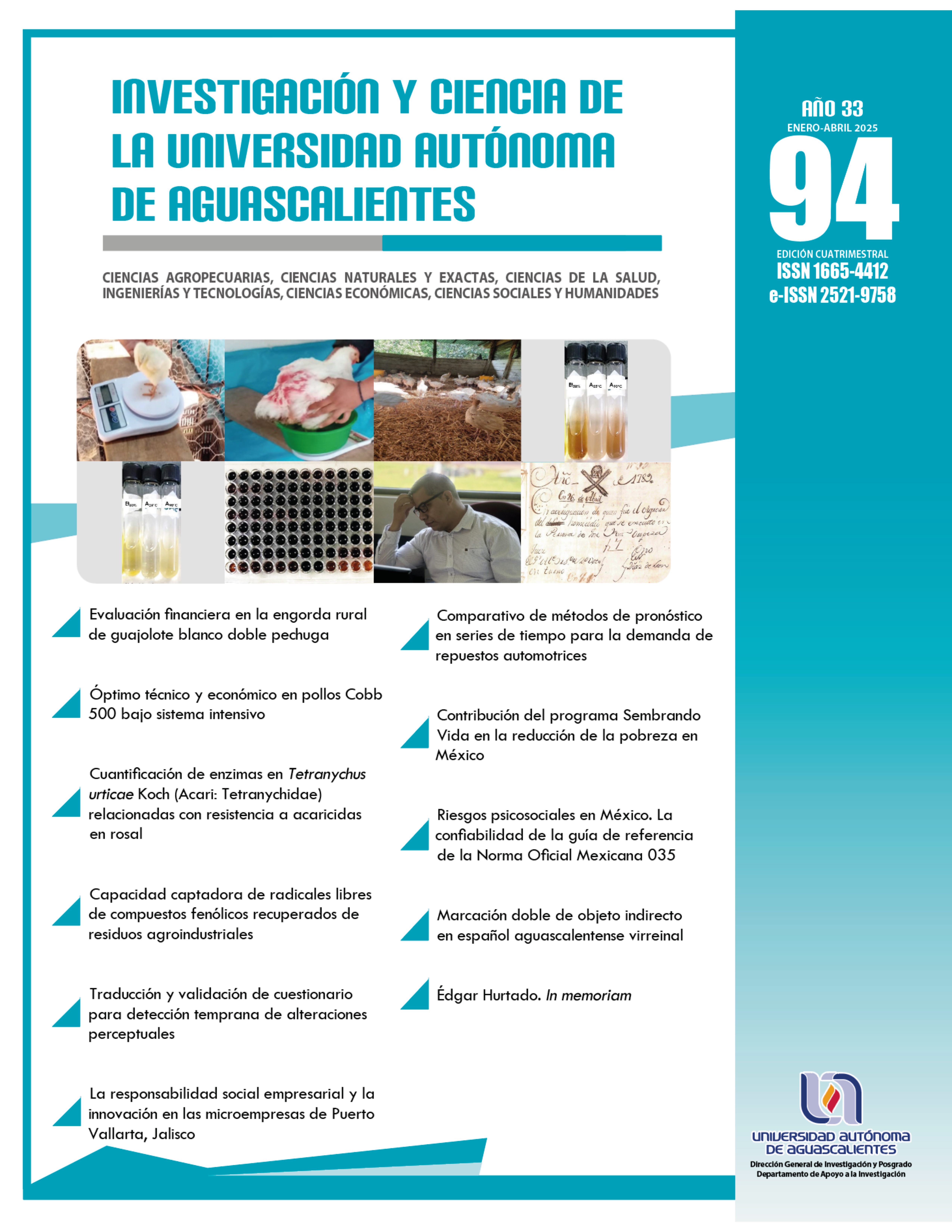Riesgos psicosociales en México. La confiabilidad de la guía de referencia de la Norma Oficial Mexicana 035
DOI:
https://doi.org/10.33064/iycuaa2025945003Palabras clave:
Riesgos psicosociales, burn-out, ansiedad, estrés ocupacional, psicometríaResumen
Los riesgos psicosociales han cobrado relevancia debido al interés en preservar la salud física y mental de los trabajadores. Evaluarlos requiere instrumentos validados y confiables. Este artículo analiza las propiedades psicométricas de la Guía de Referencia III de la norma oficial mexicana 035. Se estudió una muestra de más de 700 trabajadores del sector gubernamental, a quienes se aplicó dicho instrumento. Se evaluó la consistencia interna y la estructura teórica mediante índices como GFI, RMSR, RMSEA, NFI, y la Chi cuadrada para validar la parsimonia. Los resultados indicaron una alta consistencia interna (⍺ = .926), pero el análisis factorial confirmatorio reveló un ajuste inadecuado (GFI = .561, RMSR = .129, RMSEA = .083, CFI = .543, c2/gl = 6.008) respecto a la estructura propuesta por la norma, sugiriendo la necesidad de reconsiderar su uso como instrumento psicométrico en su forma actual.
Descargas
Citas
• Cox T.. (1988). Psychobiological factors in stress and health. In S. Fisher & J. Reason (Eds.), Handbook of life stress, cognition and health (pp. 603–623). Wiley Chichester.
• Dollard, M., Skinner, N., Tuckey, M. R., & Bailey, T. (2007). National surveillance of psychosocial risk factors in the workplace: An international overview. Work & Stress, 21(1), 1–29. doi:10.1080/02678370701254082 DOI: https://doi.org/10.1080/02678370701254082
• European Agency for Safety and Health at Work. (2007). Informe Anual 2007. España.
• Formazin, M., Burr, H., Aagestad, C., Tynes, T., Thorsen, S. V., Perkio-Makela, M., … Houtman, I. (2014). Dimensional comparability of psychosocial working conditions as covered in European monitoring questionnaires. BMC Public Health, 14(1), 1251. doi:10.1186/1471-2458-14-1251 DOI: https://doi.org/10.1186/1471-2458-14-1251
• Gobierno de la República del Perú. Ley de seguridad y salud en el trabajo 29783, Pub. L. No. 29783 (2016). Diario oficial El Peruano.
• Gobierno de la República Mexicana. NOM-035-STPS-2018 Factores de riesgo psicosocial-Identificación, análisis y prevención., Diario oficial de la federación § (2018). México.
• Goh, J., Pfeffer, J., & Zenios, S. A. (2016). The Relationship Between Workplace Stressors and Mortality and Health Costs in the United States. Management Science, 62(2), 608–628. doi:10.1287/mnsc.2014.2115 DOI: https://doi.org/10.1287/mnsc.2014.2115
• Jespersen, A. H., Hasle, P., & Nielsen, K. T. (2016). The Wicked Character of Psychosocial Risks: Implications for Regulation. Nordic Journal of Working Life Studies, 6(3), 23. doi:10.19154/njwls.v6i3.5526 DOI: https://doi.org/10.19154/njwls.v6i3.5526
• Leka, S., Jain, A., Iavicoli, S., & Di Tecco, C. (2015). An Evaluation of the Policy Context on Psychosocial Risks and Mental Health in the Workplace in the European Union: Achievements, Challenges, and the Future. BioMed Research International, 2015, 1–18. doi:10.1155/2015/213089 DOI: https://doi.org/10.1155/2015/213089
• Leka, S., Jain, A., Iavicoli, S., Vartia, M., & Ertel, M. (2011). The role of policy for the management of psychosocial risks at the workplace in the European Union. Safety Science, 49(4), 558–564. doi:10.1016/j.ssci.2010.02.002 DOI: https://doi.org/10.1016/j.ssci.2010.02.002
• Littlewood-Zimmerman, H. F., Uribe-Prado, J. F., & Gurrola R., M. A. (2020). Confiabilidad y validez de las 5 categor as del cuestionario NOM-035 de 72 tems. Ciencias Administrativas Teoría y Práxis, 16(1), 72–85.
• Luna, D., Castañeda-Hernández, D. V., Guadarrama-Arteaga, A. L., Figuerola-Escoto, R. P., García-Arista, A., Ixtla-Pérez, M. B., … Lezana-Fernández, M. Á. (2020). Psychometric properties of the Hospital Anxiety and Depression Scale in Mexican pregnant women. Salud Mental, 43(3), 137–146. doi:10.17711/SM.0185-3325.2020.019 DOI: https://doi.org/10.17711/SM.0185-3325.2020.019
• Ministerio de Protección Social. Resolución Número 002646 de 2008, Pub. L. No. 002546 (2008). Colombia: Gobierno de Colombia.
• Ministerio de Salud. Resolución Num. 1.433 (2017). Chile: Diario oficial de la República de Chile.
• Nübling, M., Burr, H., Moncada, S., & Kristensen, T. S. (2014). COPSOQ International Network: Co-operation for research and assessment of psychosocial factors at work. Public Health Forum, 22(1), 18–19. doi:10.1016/j.phf.2013.12.019 DOI: https://doi.org/10.1016/j.phf.2013.12.019
• Oficina internacional del trabajo. (1984). Factores Psicosociales en el trabajo: naturaleza, incidencia y prevención. Ginebra.
• Podsakoff, P. M., MacKenzie, S. B., Lee, J.-Y., & Podsakoff, N. P. (2003). Common method biases in behavioral research: A critical review of the literature and recommended remedies. Journal of Applied Psychology, 88(5), 879–903. doi:10.1037/0021-9010.88.5.879 DOI: https://doi.org/10.1037/0021-9010.88.5.879
• Rugulies, R., Aust, B., Siegrist, J., von dem Knesebeck, O., Bültmann, U., Bjorner, J. B., & Burr, H. (2009). Distribution of Effort-Reward Imbalance in Denmark and Its Prospective Association With a Decline in Self-Rated Health. Journal of Occupational & Environmental Medicine, 51(8), 870–878. doi:10.1097/JOM.0b013e3181a9086c DOI: https://doi.org/10.1097/JOM.0b013e3181a9086c
• Soriano Rodríguez, A., Caraveo Anduaga, J., López Jiménez, J. L., Carreño-García, S., & Juárez García, F. (2019). Internal consistency and confirmatory validity of the parenting practices inventory in a Mexican population sample. Salud Mental, 42(3), 137–143. doi:10.17711/SM.0185-3325.2019.018 DOI: https://doi.org/10.17711/SM.0185-3325.2019.018
• Uribe Prado, J. F., Gutiérrez Amador, J. C., & Amézquita Pino, J. A. (2019). Crítica a las propiedades psicométricas de una escala de medición de factores de riesgo psicosocial propuesta en la NOM 035 de la STPS en México. Contaduría y Administración, 65(1), 147. doi:10.22201/fca.24488410e.2019.1569 DOI: https://doi.org/10.22201/fca.24488410e.2019.1569
• Wheaton, B. (1987). Assessment of Fit in Overidentified Models with Latent Variables. Sociological Methods & Research, 16(1), 118–154. doi:10.1177/0049124187016001005 DOI: https://doi.org/10.1177/0049124187016001005
Descargas
Publicado
Cómo citar
Licencia
Derechos de autor 2025 Luis Roberto Domínguez-Aguirre, Israel Lozano-Jiménez, Juan Carlos Briseño-Navarro, César Alí Romero-Guardado

Esta obra está bajo una licencia internacional Creative Commons Atribución-NoComercial-CompartirIgual 4.0.
Las obras publicadas en versión electrónica de la revista están bajo la licencia Creative Commons Atribución-NoComercial-CompartirIgual 4.0 Internacional (CC BY-NC-SA 4.0)









